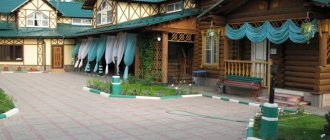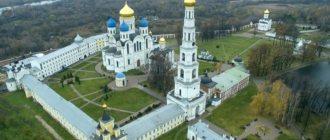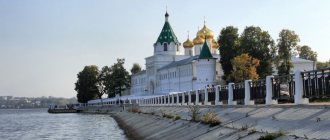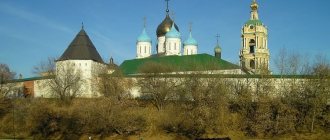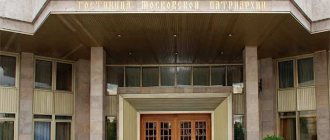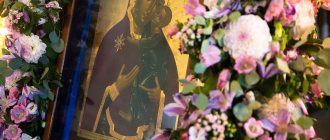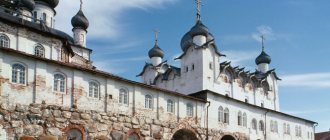The Optina Pustyn monastery is known to many pilgrims. Why is it called that way? The word “Optina” comes from the name of the founder of the monastery, a former robber, who, with the Blessing of God, repented of all his sins and created a monastery (“Pustyn”) for solitary and soul-saving prayers.
However, there is another version of the origin of the monastery. There is an assumption that the founder of the holy place was a certain Vladimir the Brave. In the 14th century, he chose a deserted and no-man's territory among an impenetrable forest to build a monastery for repentant hermit sinners. How to get from Moscow to the monastery and its features will be discussed further.
What is Optina Pustyn famous for?
Optina Pustyn is famous not only for its magnificent churches, cathedrals and bells. The most important pearl of the place is the tombs of the venerable Optina elders, located in the temples of the monastery. This is the soul, the living miraculous treasury of the entire complex as a whole, which attracts and gathers pilgrims and Orthodox believers not only from Russia, but also from all over the world.
Optina Pustyn provides shelter and consolation to orphans, sick people, and pilgrims. It is called the “Orthodox university” of all Orthodox Christians, and primarily because the great elders prospered in the monastery, among whom Father Ambrose enjoyed special spiritual authority.
Where is
Optina Pustyn is located in the central region of the European part of Russia, on the territory of the Kaluga Orthodox Diocese. However, in essence, it is a stauropegic monastery, since it is directly subordinated to the patriarchate of the Russian Orthodox Church.
Geographically, the monastery is located in the Kaluga region, 72 km from the regional center and 2 km from the city of Kozelsk. The Zhizdra River, a tributary of the Ob, flows next to the cathedral complex.
The road to the place of pilgrimage will give the traveler a lot of unforgettable impressions, since on the way to the monastery magnificent views open up, reflecting the harmonious combination of the shy beauty of the region’s nature with the spiritual principles of Orthodoxy.
Where to stay
If you plan to stay overnight in the monastery, you should arrange a hotel in advance. There is a pilgrimage hotel on the territory of the monastery. But most often it is booked for organized groups and the conditions there are quite modest: eight people in a room and amenities on the floor. The nearest hotels and guest houses can be found in Kozelsk. There are also good options for accommodation in apartments, in other words, apartments. The apartment option is even more interesting, because Kozelsk is not very good with public catering outlets. There is a refectory at the monastery for pilgrims, but it is not open in the evening.
History of origin
Vvedenskaya Hermitage (otherwise known as a settlement of monks) bears the name of a man about whom little is known. Opta was the leader of a band of robbers who committed robberies in the forests near Kozelsk. For unknown reasons, the inveterate robber repented and became a monk.
Being a monk, when he was tonsured, he was given the name Macarius. Therefore, during the period of its inception (in the middle of the 15th century), the settlement of monastics near Kozelsk began to be called Makarievsky.
The history of the monastery is silent about the life of the founder of the desert, and the place of his burial is also unknown. However, the monastery complex still bears his name.
According to another version, the fact of the founding of the desert belongs to Vladimir the Brave. In the 14th century, prayer hermits appeared in this place. It is assumed that the prince decided to make a secluded prayer monastery here - away from human settlements, in an impenetrable forest, on land unsuitable for agriculture.
From that time on, the place of prayer and the monastery itself were subjected to either spiritual flourishing or shameful oblivion. The difficult years “without time and without God” affected the life of the monastery. However, people have always been drawn here, as to a lighthouse and a soul-saving haven. Well-known writers, politicians, and clergy of their era visited here.
The history of the birth of Optina Pustyn:
| Period | Events, facts |
| 1146 | The first mention in the chronicle of the city of Kozelsk. |
| Since 1213 -… | The territory of ancient Kozelsk and Optina Pustyn was inhabited by Vyatichi people who professed the teachings of St. Kukshi. |
| Since 1238 -… | Kozelsk was taken by the Tatars. In the 14th century it came under the control of Lithuania. Then the city passed several times under the control of different leaders, but ultimately remained under the rule of Moscow. |
| 1625-1689 | A group of prayer hermits settles near the city of Kozelsk and establishes a settlement. In 1625, Abbot Sergius became the head of the settlement (monastery). A few years later, the first church and several cell rooms were built, and in 1689, boyars from local residents erected a cathedral. |
| 1704-1727 | The mill was taken away from the monastery. In 1724, by decree of the Holy Synod, the monastery was abolished. At the request of boyar A. Shepelev in 1726-1727. the monastery was restored, the monastery and its mill were returned. |
| Since 1795 -… | From that time on, the monastery began its active development. By appointment of Metropolitan Platon, new leadership came to the monastery - Filaret (Bishop of Kaluga), Hieromonk Joseph. With their arrival, the monastery began to actively rebuild. |
| 1796-1829 | Fr. was appointed to serve at the monastery. Abraham (hieromonk), who became the founder, architect and builder in one person. Metropolitan Platon really liked the innovations taking place in the monastery, and by his decree the monastery began to receive 300 rubles. for further construction annually. The Synodal Assembly appointed 23 more people to serve in the Optina Monastery. Thus, the eldership was born in the Kozelsky monastery. |
| 1830-1861 | This period of time was the full flowering of the holy monastery. The total number of spiritual brethren was already 150 people, and 20 of them were of high clergy. Since 1840, the confessors of Optina Pustyn began to publish soul-helping Orthodox literature, translate and publish books of great people and spiritual mentors. |
| 1862-1891 | During these years, Hieroschemamonk Ambrose (in Orthodoxy - Ambrose of Optina) was in charge of the monastery; among the common people he was simply called Father Abrosim. He was a man with a big soul and understanding of human nature. Sick, crippled, disillusioned people with life came to him, and the elder found a special approach for each, which earned him sincere love and respect. During these years, Fr. Ambrose founded the Kazan convent in Shamordino, where he lived for more than a year, instructing nuns and sisters in spiritual teaching and self-development. |
| 1892-2000 | The period of formation of Soviet power and the weakening of spiritual principles had a tragic impact on the life of Optina Pustyn. In 1923, the monastery was closed by the Bolsheviks. Part of the monastery premises was given over to a sawmill, and the guest rooms were used as a rest home. But in 1987, Optina Pustyn was reborn. All premises were returned to the monastery, and on June 3, 1988, a prayer service was held for the first time after disgrace. In 1996, the priests of the monastery were canonized, and in 2000, the monastery was designated by the Council of Bishops as a particularly revered shrine of the Russian Orthodox Church. |
History of the monastery
There are three versions of the origin of this abode of God. According to the first, in the 14th century, the fierce and formidable robber Opta lived in the Kaluga forests. He was the leader of the robber "brotherhood". He attacked merchant convoys, robbed them, and brutally killed people.
History is silent about what happened to the mighty Opta, why he suddenly reconsidered his life. He looked at her from the other side and was horrified. He immediately left the band of robbers. The path of the repentant sinner to God began. Opta took monastic vows with the name Macarius and became the founder of the Optina Hermitage in the impenetrable forests near Kozelsk.
According to the second version, everything is much simpler. The date of foundation of the monastery is unknown. Why is it called Optina? Because it used to be mixed, that is, for both monks and nuns. And such ascetics were called Optinas.
And the third version tells that the monastery was founded by unknown ascetics. They went away from human eyes, into impenetrable forests. The forests near Kozelsk, across the Zhizdra River, are the very place where you can hide from prying eyes. The land here is unsuitable for arable farming, which means no one will encroach on it.
One way or another, Saint Optina Pustyn is one of the oldest monasteries in modern Russia.
Optina Pustyn today
In the Optina Pustyn monastery there is a large complex of buildings for both service and economic purposes. Getting to this place from Moscow is simple and doesn’t take long. In the monastery, for a believer, everything is thought out to the smallest detail, because it is not in vain that so many generations of monks worked on this.
Leonid Mozhaisky in front of the clergy of the Optina Pustyn Monastery
Now the Optina Monastery is under the authority of Bishop Leonid of Mozhaisk, vicar of the Patriarch of Moscow. There is an active spiritual life in the monastery; every day it receives a huge number of pilgrims and guests from all over Russia. In all churches and cathedrals of the Desert, prayer services and liturgies are held, according to the internal Optina and Orthodox calendars.
All church sacraments are performed here:
- Confession.
- Participle.
- Blessing of Unction.
- Baptism.
- Consecration.
- Unction.
- Funeral service.
- Memorial service.
In addition, every evening after a meal in the monastery, a procession of the cross is held around the entire territory of the monastery, and on Saturdays a divine litany for the murdered monks is read at the necropolis of the monastery.
Temples of Optina Pustyn
Several temples were built in Optina Pustyn throughout the history of its existence. Now there are 8 churches in the monastery, in which divine services take place every day. On great holidays, when there are large crowds of pilgrims, services are held in 2-3 churches at a time.
Operating temples:
1. "Vvedensky". Has 3 thrones. Location of the relics of St. Ambrose, Art. Nectaria. Every day in the church there is a midnight service, liturgy, prayer service for St. Ambrose.
2. "Kazansky". Three-throne. Location of the relics of St. Isaac, st. Moses, Art. Antonia. On holidays and weekdays, an all-night vigil and liturgy are held.
3. "Vladimirsky". Single-Altar Church, custodian of the relics of the elders:
- Barsanuphia;
- Macaria;
- Leo;
- Joseph;
- Anatoly (Zertsalova);
- Anatoly (Potapova);
- Hilarion.
Every day there is a confession and a prayer service for the departed elders.
4. "Preobrazhensky". Has one throne and keeps the relics of St. Raphael. A prayer service and blessing of water are held here daily.
5. “John the Baptist”. Single-throne, located in the monastery. The service is held according to a special charter.
6. Temple of Hilarion the Great. The single-altar church was built behind the wall of the monastery. Baptisms, weddings and funeral services take place here.
7. Temple "Bread Spreader" The single-altar church is located on the territory of outbuildings. Here the “Indestructible Psalter” is read throughout the year without interruption.
8. Mobile temple ik. "Life-giving spring" A prayer service is held in the single-altar sanctuary on the site of the monastery's garden plots.
Eldership
The elders of Optina Hermitage, according to reviews, help with lightning speed. All of them are glorified as saints.
Where did old age begin? From Metropolitan Philaret. When he came to power, he strongly supported the revival of eldership in Optina Hermitage. He himself loved silence very much, often visiting the monastery, sometimes staying there for several weeks. It was Philaret who invited two hermits to the monastery - Moses and Anthony. As you might guess, they became the first Optina elders. The Monk Moses of Optina and the Monk Anthony of Optina were students of those who studied with Paisius Velichkovsky. This elder saw the need for the revival and continuation of eldership as salvation for human souls.
And the Venerable Ambrose of Optina? Great saint, canonized in 1988. Through his prayers, miracles are being performed today. In total, 12 Optina elders are known.
Alas, now there is no such flowering of old age. Neither in Optina, nor anywhere else. These were the last “lamps” in Rus'.
Optina monastery
St. John the Baptist monastery is located at a distance from the monastery, behind a small grove. When it was built, they decided to preserve the trees and a small forest so that the monastery would be hidden from view. On weekdays, the monastery is closed to lay people; entry is allowed only on memorable dates and holidays.
The Church of St. John the Baptist is built of wood; it “remembers” the times of the birth of eldership in the Optina Monastery. During patronal feasts, you can pray here and take part in prayer services and liturgy.
Holy springs
Near the Optina Monastery there are several consecrated springs and a well. All of them are not far from the monastery; monks and pilgrims walk to get holy water.
Holy springs of the monastery:
1. Source of St. Paphnutia.
It is consecrated in the name of St. Pafnutia (Borovsky). The saint's memorial day is celebrated with a religious procession, at the end of which a prayer service is performed with the blessing of water.
2. Source of Seraphim of Sarov.
The source is located in the monastery. Monks visit this place with special inspiration and great trepidation. The source has a small fence and a cross with an icon of Father Seraphim.
3. Amvrosievsky well.
Ambrose Optinsky indicated the location for the well. Now this is a special place for monks and pilgrims.
4. Source of St. Paraskeva.
The source is located in a quiet place in the forest. It was consecrated in the name of the Great Martyr. Paraskeva Pyatnitsa and is the property of the Optina Monastery.
Relics of Ambrose of Optina
The relics of St. Ambrose of Optina were found in 1998 with the blessing of the Patriarchate of the Russian Orthodox Church. Having received the blessing, the brethren of the holy monastery opened the grave of the elder buried in the monastery necropolis. Particles of the elder’s relics were placed in a reliquary, which was installed in the Vvedensky Cathedral (left side chapel) of the Optina Hermitage.
Since then, the flow of pilgrims to the shrine with the relics of the holy elder has not dried up. During his life, Ambrose of Optina helped everyone who came to him with requests and for prayerful help.
He was distinguished by his special virtue and love for all parishioners, and was a shining example of selfless and selfless service to people. But even now he does not leave his spiritual children. Anyone who, in a high spiritual impulse, turns to him with sincere prayers receives what he asks for.
Renaissance
It all started in 1987. It is easy to imagine in what form the monastery was transferred to the Russian Orthodox Church. And what did the monks who came here to restore it see? On November 17, 1987, the Soviet government returned the devastated monastery to the monks. And already in June 1988, the first liturgies began to be served in the Vvedensky Cathedral.
In 1988, the Monk Ambrose of Optina was canonized. In 2000, the Council of the Optina Elders was glorified for universal veneration.
Today Optina Pustyn is one of the most beautiful monasteries, where many pilgrims come every day.
Schedule of services
You can find out how to get from Moscow to the Optina Pustyn monastery by looking at the monastery location map. And you can get acquainted with the schedule of all services on the official website of the monastery itself, which is regularly and periodically updated.
Services schedule:
- 30:00 – midnight service (Vvedensky Cathedral).
- 00 o'clock – Liturgy of wounds. (Vvedensky Cathedral, Kazan Church).
- 00 o’clock – liturgy late. (Vvedensky Cathedral, Kazan Church).
- 00 a.m., 13.00 p.m. – prayer reading with akathist Art. Ambrose of Optina (Vvedensky Cathedral).
- 00 o’clock – prayer reading and Cathedral Akathist of the Optina Elders (Vladimir Church).
- 00 o’clock – evening service.
How to get to Optina Pustyn from Moscow
You can get to Optina Pustyn by any transport or even on foot. It is located 270 km from Moscow and the entire journey, depending on the type of transport, can take no more than 4 hours.
By car
The easiest way to get to the Optina Monastery is by car. You need to leave the capital along the Kievskoye Highway and follow to Kaluga. Before the city you should turn right, towards the bridge over the Oka River. Following the road signs, you need to get to Kozelsk, turn left there and follow the sign “Optina Pustyn”.
By train
Local residents can tell you how to get from Moscow to the Optina Pustyn monastery by train.
First, you need to get to Kaluga by express or regular train from the Kievsky railway station. Next, from the Kaluga bus station, get to Kozelsk, and then to Optina Pustyn - by taxi or on foot.
By bus
You can get to Kaluga by bus from the Yugo-Zapadnaya metro station. An intercity bus to Kozelsk leaves almost every hour (9 trips in total). From the city of Kozelsk to Optina Pustyn you can take a taxi or walk.
Murder
It was committed by a certain Nikolai Averin. It is known that bell ringers were pierced with a sword. They hit me in the back with such force that my internal organs were cut. This happened at 6 o'clock in the morning.
Hieromonk Vasily was also killed by a blow to the back. He did not die immediately. He lived for about another hour.
According to the pilgrims who stood at the bus stop and waited for the first bus to Kozelsk, at the hour of the murder a strange red glow appeared in the sky above Optina. It was as if blood was spurting out. But then they didn’t even think about blood, they were simply surprised at the unusual phenomenon.
The killer was arrested a week later. He took his punishment.
Accommodation and meals
The monastery has a hotel for pilgrims. It is possible to rent inexpensive housing from local residents living near the monastery.
The following settlements are offered for pilgrims:
1. Guest houses for pilgrims (shared).
Guest houses with rooms for 8 people, a tea room and a shared toilet on the floor. Pilgrims of the general settlement provide their own food.
Accommodation – 300 rub./night/person.
2. Guest 5-room houses.
Guest houses with shower, dining room.
Accommodation (with meals):
- 1-seater room – 1000 rub./night;
- 2-3-seater room – 800 rub./night/person;
- 4-seater room – 600 rub./night/person.
3. Cells of the Baptist Skete (for men only).
Settlement in the monastery is possible only for men after an interview with the abbot, for a long stay in the monastery, for labor in obediences.
4. Hotel for clergy.
There is a hotel for priests and monks on the southeast side of the monastery, and a certified ID from the diocese is required to participate in services.
There are no shops or eateries on the monastery territory and the nearest village, so it is recommended for guests to take packed lunches with them, and there is always hot tea and pastries in the refectory monastery.
It's time to go to Optina!
Optina Pustyn
I once wrote and can repeat it ten years later:
“My dear Optina! My friends, my dear friends! Do you want to feel this tenderness, this strange softening of the heart? This yielding to blissful tears? Is this a feeling of childish delight? Love for everyone and everything around you? Forget about fancy sea beaches and expensive resorts! To Optina, quickly to Optina! What you experience here you will never forget, and these feelings will make you come back again and again.
What is this, why is this? My dears, this is the grace of God, which touches our hardened heart and evokes this love and tenderness with which my story is so full.”
What can I add? Summer has passed the halfway point, and if you have not yet made a pilgrimage to Optina Pustyn, the time has come to do it!
Optina Pustyn
***
How to get there
Let's start with the road.
First option
You can get from Moscow to Optina by bus, which goes from the Teply Stan bus station. The bus station is located 50 meters from the Teply Stan metro station (Kaluzhsko-Rizhskaya line, orange line). The bus takes about five hours, a little more or less, depending on traffic jams; makes two long stops lasting 20 minutes each - in Obninsk and Kaluga, you can get out and stretch your legs, buy something edible, and visit public places.
Bus schedule to Optina Pustyn and back.
Ticket price: 650 rubles.
From the bus station in Kozelsk to the monastery there is a minibus “Bus Station - Optina Pustyn” once an hour: 7:30, 8:10, 9:10, 10:10, 11:10, 12:10, 13:10, 14:10 , 15:10, 16:10, 17:10. Travel time: 10–15 minutes, fare: 20 rubles. Sometimes the first and last flights - at 7:30 and 17:10 - are cancelled. This minibus does not operate on Mondays.
You can take the Kozelsk - Sosensky minibus, which runs more often, at intervals of 10–15 minutes, and get off at the stop before the turn to Optina, having warned the minibus driver in advance. From the turn to the monastery there are two kilometers, and if your luggage is not heavy, you can walk.
You can call an inexpensive taxi "Rush", taxi phone number: +7-48-442-3-000-3. The fare is about 100 rubles. If you are traveling with three or four people, it will cost the price of a minibus ticket.
Second option
If you don’t want to take the bus, you can take the train from Moscow’s Kievsky Station to Kaluga.
The train schedule is here.
Travel time is about 3.5 hours, fare is 450 rubles. You can take the express, then the travel time will be reduced by an hour, but the cost will increase to 530 rubles.
There are buses from Kaluga to Kozelsk. Schedule here. Travel time is about two hours, cost is 188 rubles.
So in terms of cost and travel time, both options are approximately equivalent.
***
Where to stay and eat
You have arrived in Optina. It's time to take care of a place to stay for the night.
Near the walls of the monastery there are hotels for pilgrims: eight-bed rooms, a bathroom on the floor. The cost of accommodation is 300 rubles per day. A passport is required upon check-in.
Pre-booking of the hotel is made only for organized pilgrim groups by calling (48442) 50-166 , but none of the pilgrims stay on the street; pilgrim service workers always take care of their accommodation.
You can eat in the pilgrimage refectory (to the right of the Holy Gates of the monastery), asking for food coupons at the hotel, or in the teahouse, where there is a lot of varied and tasty monastery food: cabbage soup, dumplings with fish (60 rubles), dumplings with potatoes, cabbage (50 rubles), chebureks and belyashi with fish (50 rubles), various pies (with potatoes, lentils, jam, cabbage, etc. - 20 rubles), khachapuri, pancakes with fish and cottage cheese, monastery bread, pizza with seafood, monastery pickles and dairy products from the monastery's subsidiary farm, a variety of salads, Optina honey and other goodies, tea, coffee, juices.
There are five-room guest houses near the monastery; they are more comfortable, but also more expensive. Here you will find a shower, a dining room, lunch and dinner from the monastery pilgrimage refectory.
Accommodation cost:
- single room – 1000 rub./night;
- double or triple room – 800 rub./night per person;
- four-bed room – 600 rub./night per person.
Find out more about living in Optina here.
Forerunner Skete
Male pilgrims who come for a long period of time to work at monastic obediences, after an interview, can settle in the Baptist Skete.
Rules for check-in and stay at the monastery’s pilgrimage hotel here.
There are two bookstores in the monastery, where they sell spiritual books, icons, rosaries, and a shop where they sell church utensils, vestments, etc.
***
Divine services
The canopy and under it granite crayfish with St. with the relics of the St. Optina Elders. Leo, etc. Macaria (foreground)
During the day, the main churches of the monastery - Vvedensky, Kazansky, Vladimirsky and Preobrazhensky - are always open
During the day, the main churches of the monastery - Vvedensky, Kazansky, Vladimirsky and Preobrazhensky - are always open. Everyone is blessed with free entry and access to the holy relics of the venerable elders of Optina .
More details about the temples here.
Every day two Liturgies are served in Optina: an early one at 7:00 (Clock at 6:40) and a late one at 10:00 (Clock at 9:40).
On weekends and holidays, three Liturgies are served: the early Liturgy begins at 6:30 (Clock at 6:00), the middle one at 8:00 (Clock at 7:40), the late Liturgy at 10:00 (Clock at 9:40) .
In addition, prayer services with akathists are served every day:
- St. Ambrose of Optina - in the Vvedensky Church at 13:00;
- The Synaxis of the Reverend Elders of Optina - in the Vladimir Church at 15:00.
Evening service begins at 17:00 (9th hour at 16:45).
Kazan Temple. Here are the relics of the elders
Confession takes place daily from 6:00 in the Vladimir and Kazan churches.
Detailed schedule of services is here.
In the Church of the Transfiguration there are water-blessing prayers and you can always get holy water.
You can swim in the spring of St. Paphnutius of Borovsky at any time. Go from the barrier to the right (there is a sign).
A detailed plan of the monastery and monastery is here.
Candles in churches - from 10 rubles, custom notes about health and repose - 10-12 names - 10 rubles. Prosphora is available in churches and in a kiosk under the bell tower; a donation for a prosphora is 5 rubles.
The official website of Optina Pustyn with a wonderful design, easy navigation and even a 3-D tour is here.
***
What else to see in Kozelsk
Local Lore Museum of Kozelsk
local history museum in Kozelsk ; it was founded in 1957 and is one of the oldest museums in the region. Exhibits symbolizing the heroic seven-week defense of Kozelsk in 1238 are stored here, there is a diorama “Defense of Kozelsk from the Mongol-Tatars.” There are also exhibitions dedicated to the nature of the Kozelsky region, its archaeology, ethnography and the Optina Hermitage.
Museum address: Bolshaya Sovetskaya street, 75.
By minibus we reach the intersection, turn right and walk 200 meters. The museum is open daily from 10:00 to 17:00, Monday is a day off, the last Friday of each month is a sanitary day.
Phone: 8(484-42) 2-24-65.
Read more about the museum.
***
Also in Kozelsk there is a forest museum “Forest Origins” , opened in 2001 (mechanical plant area). The museum consists of three halls: historical, nature and fauna, and also dedicated to Russian wooden architecture. There is an extensive video library with films about the life of animals, birds, insects, nature reserves and ecology. The museum also widely presents the history of the development of forestry in the Kaluga region (detailed information here).
House of Nature : Bolshaya Sovetskaya street, 71.
***
beautiful ancient churches in Kozelsk : the Annunciation Church (1810), the Assumption Cathedral (1824), the Church of St. Nicholas the Wonderworker (1740), the Church of the Descent of the Holy Spirit (1789).
***
In the city Park of Culture there is an observation deck from which an amazing view of the Zhizdra River and Optina Pustyn opens.
About the sights of Kozelsk here.
***
Monastery in Shamordino and the monastery of the Savior Not Made by Hands of the Hermitage
Kazan Ambrosievskaya stauropegial female hermitage
Not far from Optina there is the Kazan Ambrosievskaya stauropegial women's hermitage , founded by the Monk Ambrose of Optina near the village of Shamordino in 1884. The entire monastic charter and the sisters’ routine were established by the elder himself.
Under the spiritual leadership of the Optina elders, the monastery became one of the largest monasteries in the Russian Empire, remaining so until its closure and ruin in 1923. Until 1990, the premises of the monastery were used as educational buildings for an agricultural technical school.
Monastic life has been resumed since 1990, the wonderful cathedral in honor of the Kazan Icon of the Mother of God, architect S.V., has been restored. Sherwood.
Currently, more than 120 nuns are working in the monastery under the leadership of Abbess Sergius (Shcherbakova).
The temples of the monastery are decorated with wonderful icons, embroidered with gold, beads, and decorated with semiprecious stones - handmade by the sisters of the monastery. There are wonderful holy springs here.
Monastery website: https://www.shamordino-m.ru/.
Information for pilgrims: https://www.shamordino-m.ru/palomnikam/info/.
You can get to the monastery by bus "Kozelsk - Kaluga". Go to the “Kamenka” stop, then walk two kilometers or, if you’re lucky, hitch a ride. You can take a taxi, the cost from Optina is approximately 400 rubles.
***
Monastery of the Savior of the Hermitage Not Made by Hands in the village of Klykovo
Not far from Optina there is a monastery of the Savior of the Hermitage Not Made by Hands : https://www.klikovo.ru/.
Pilgrims are especially attracted here by the grave and cell of the famous elder schema-nun Zipporah . You can read about the oxbow here.
***
It's time to go to Optina Pustyn!
Guardian Angel on the road! Through the prayers of our holy fathers, the elders of Optina, Lord Jesus Christ our God, have mercy on us!
Best time to visit Optina Pustyn
How to get from Moscow to the Optina Pustyn monastery and choose the best time for an excursion or pilgrimage trip can be found on the official website. There are always guests at the Optina Monastery. However, the largest influx of pilgrims occurs on the twelve holidays, Easter, Epiphany, and Christmas.
If your soul asks for solitary prayer, or maybe even to work for the glory of God as a laborer, it is better to go to Optina Pustyn on ordinary weekdays, maybe even during fasting. And if you want to join the general joy on a holiday, then a trip to Optina Pustyn should be timed to coincide with Great Dates, Twelfth Feasts or patronal services in the monastery churches.
Program of stay in Optina Pustyn
The best thing is to set aside 3 free days for your trip to Optina Pustyn. This is the best time to explore all the sights of the monastery without fuss, visit the tombs of the elders and take part in the spiritual vigil at the monastery services.
The first day
On the first day, it is imperative to visit the elders, venerate the holy relics and, secretly, ask them for a blessing for a short stay “guest” with them. In the evening, having rested a little from the road, you should join the evening service in one of the monastery churches.
Second day
The next day should begin with confession and holy communion. After lunch, it’s time to walk around the monastery, without rushing to look at all the temples and buildings. As a rule, all premises of the Optina Hermitage are open to pilgrims, except for the Optina Skete .
Entrance to this room is allowed only to the monastic brethren, and it can only be viewed from the outside.
In the library building of the monastery you can once again refresh your memory of the facts of the history of the creation of the Hermitage, and the monastery shop will offer to purchase books, icons and church souvenirs. If you have time and desire, you can work a little in the monastery. The monastery gladly accepts the help of voluntary workers.
It will be very good to join the evening service in the main and very beautiful Vvedensky Cathedral. In the evening you can take a walk outside the monastery, walk in a pine forest, go down to the Zhizdra River, and watch the sunset in spiritual solitude.
Day three
In the morning you need to get ready to get up for midnight prayer. This is a prayer for the beginning of a new day, where the singers on the choir sing “Behold the Bridegroom is coming...”. Then, having eaten the lunch meal, you can set off on the return journey with spiritual peace and the joy of Divine Communion.
Optina elders
Optina Pustyn is famous for its holy elders. One of the founders and first elders is Hieroschemamonk Lev, who knows how to see all the secret sins of a person and his innermost thoughts. Hieroschemamonk Macarius preached with him and wrote manuals on spiritual life for the laity.
The brothers Moses and Anthony were engaged in the creation of new temples. During their active work, Optina Pustyn was enriched with new buildings.
The head of the hermitage, Hieroschemamonk Anatoly, was engaged in the instruction of not only the Optina monks, but also many other monks and nuns. The image of the Mother of God appeared to Hieroschemamonk Joseph more than once; even during his lifetime, a gracious glow emanated from him. Hieromonk Nikon did not leave spiritual services even after the monastery was closed.
The last elder of the desert experienced persecution and died in exile. Archimandrite Isaac witnessed the devastation and desecration of the Optina Hermitage. He was persecuted by the authorities, sent to prison more than once, and in 1938 he was shot.
In the 30s of the last century, during difficult times for Christians, many elders and monks of Optina Hermitage experienced persecution by the authorities. During this period, 15 clergy were injured. They are recognized by the Orthodox Church as new martyrs.
About these newly glorified saints, the publishing house of Optina Pustyn wrote the work “Optina Pustyn. Years of Persecution”, and also published the collection “Lives of the New Martyrs and Confessors of Optina Hermitage”.
What can you bring from Optina Pustyn
No matter how amazing and exciting the trip is, you always want to bring something special as a souvenir from a holy place. Moreover, Optina Pustyn is very generous with gifts. On the territory of the monastery there are several Orthodox shops, where everyone can pick up a pleasant and very useful souvenir. And this is not just a gift, it is a piece of grace from a place prayed for centuries.
The best gift can be an icon. Here you can purchase icons with the faces of the Optina elders, icons of St. Ambrose of Optina and all the saints who have ever served in this monastery.
You can also bring:
- books;
- lives of saints;
- lamps;
- body crosses;
- beads.
From the Optina Monastery you definitely need to take away blessed water, oil of oil and some earthen soil in a bag.
But the most important thing for a person is to bring home a piece of that grace that he was lucky enough to plunge into and not “lose” it along the way.
1625-1796
According to reviews, Optina Pustyn is the place where the soul, exhausted by the bustle, gratefully rests. And this has been the case since the establishment of the monastery.
What do we know about her first “steps”? It is known that in 1630, instead of a luxurious monastery, there was only a wooden church. The picture was completed by several cells. And the brethren numbered only 12 people. Not a lot, compared to subsequent years.
And yet the monastery existed. Under the direction of Hieromonk Theodore, the brethren carried out their obedience. The then Tsar, Mikhail Fedorovich, allocated land for vegetable gardens to the monastery and donated a mill. And in 1689, the Vvedensky Cathedral was built on the territory of the monastery. Life in the monastery was slowly getting better.
Alas, in 1704 the mill was taken away and the Zhizdra River was forbidden to be used for fishing. It became very difficult for the inhabitants, but with God’s help they continued their lives. The monastery became poor, its economy fell into decay. Moreover, Peter I tried his best and issued a decree according to which the monastery had to pay rent to the state treasury. Naturally, this “tribute” to his own king was beyond the strength of the impoverished monastery. But Peter doesn’t care: he needs money for the war with the Swedes, so he collected it from everyone.
In 1724, poverty was such that Optina Pustyn was abolished. And now she went to the Belevsky Spaso-Preobrazhensky Monastery. Why did they do this? Firstly, due to the fact that there were very few inhabitants in Optina. Only 12 people. The monastery was considered “little-brotherly.” And secondly, there was an unaffordable rent.
True, this unification with the Belevsky Monastery lasted for two years. In 1726 the monastery was restored as an independent one. By decree of Catherine I, by the way. But during these two years, the wooden buildings of the monastery fell apart and fell into complete disrepair.
A year later, in 1727, Optina Hermitage was given back its mill - a gift from Tsar Mikhail Fedorovich - and access to fishing.
The monastery slowly rose. So, in 1741 they began to build a bell tower. And in 1750 - the Church of the Entry of the Blessed Virgin Mary. Construction lasted almost 10 years.
But again reforms. This time Catherine II wanted to intervene in the life of the monastery. The empress did not think for long. With her light hand, namely thanks to the reform, Optina Pustyn became a secondary monastery of the Krutitsa diocese. This happened in 1764.
9 years have passed. The monastery managed to rebuild the cathedral church. Generous benefactors helped. But inside the monastery everything was very sad. In 1773, only 2 monks remained in it. And those are old people.
It is not known how the matter would have ended, but in 1795 Metropolitan Platon of Kaluga and Moscow visited the monastery. He liked the wondrous place so much that the Metropolitan ordered to send a very experienced monk to the monastery. Hieromonk Abraham became its rector.
Excursions
How to get from Moscow to the Optina Pustyn monastery, get all the necessary information and book a place in the pilgrimage hotel, you can find out in the monastery excursion service, which operates every day without days off and lunch breaks. You can also book hotel rooms for organized groups of pilgrims and find out the schedule of all services on the official website of the monastery.
For reference: donation to the monastery on a group excursion is 150-200 rubles per person. (for adults), 50 rub./person. (for children), donation for an individual excursion - from 2000 rubles.
The Optina Pustyn monastery is called nothing more than a “spiritual sanatorium”. This is the most favorite place for a believer, therefore a huge flow of Orthodox Christians comes here from Moscow and other cities of Russia, where they find spiritual consolation, joy and peace.
Author: Severyanochka
Article design: Vladimir the Great
Vvedensky stauropegial monastery Optina Pustyn Stavropegial monasteries of the Russian Orthodox Church
The all-Russian glory of the monastery begins in the 1820s, when, with the blessing of St. Philaret (Amphiteatrov), the Baptist monastery was built in the monastery. Optina Pustyn became one of the spiritual centers of Russia and rightfully occupied a very special place in the history of the Russian Church due to the severity of monastic life and the abundance of spiritual exploits of its elders. The authority of the Optina elders was extremely high. From all over the country, Orthodox Christians flocked to these “teachers of life” in search of answers about the meaning of life and salvation, for advice and consolation, prayer and solutions to perplexed questions. Women (both laywomen and nuns) were prohibited from entering the monastery where the elders lived. The elders received pilgrims in a special “hut” room, which had a separate entrance outside the monastery. The desert has become a spiritual hospital for all those seeking admonition, consolation, the meaning of life and spiritual guidance. It is not for nothing that this monastery was called “the hottest spiritual fire, around which all of Russia was warmed.”
Outstanding representatives of Russian culture of the 19th century, the flower of the Russian intelligentsia, came here: N.V. Gogol, K.N. Leontyev, V.S. Soloviev, I.V. and P.V. Kireevsky, A.M. Zhemchuzhnikov, A.K. Tolstoy, F.I. Tyutchev, Venerable Martyr Grand Duchess Elizaveta Feodorovna. N.V. Gogol retained memories of the fertile Desert throughout his life, he wrote:
“Several miles away, approaching the monastery, you can already hear a fragrance; everything is becoming friendlier, bows are lower and there is more concern for people...” In 1877, after the death of his son, F.M. lived in the skete of the monastery. Dostoevsky. Some details in the novel “The Brothers Karamazov” appeared under the impression of this trip, and the Optina elder Ambrose
(Grenkov) served as the prototype for Elder Zosima. L.N. also visited the monastery several times. Tolstoy, the last time a few days before his death.
The Lord so wisely arranged that the eldership in Optina was not interrupted for more than a hundred years: it passed from one spirit-bearing elder to another. The fourteen elders of Optina are venerated as saints; their names are well known to all believers. Holy elders Leo (1768–1841), Macarius (1788–1860), Moses (1782–1862), Anthony (1795–1865), Hilarion (1805–1873), Ambrose (1812–1891), Isaac I (1810–1894) ), Anatoly I (1824–1894), Joseph (1837–1911), Barsanuphius (1845–1913), Anatoly II (1855–1922), Nektary (1853–1928), Nikon (1888–1931), Isaac II (1865 –1938) were distinguished by their insight, prudence, and gifts of healing and miracles.
;In the 20th century, Optina Pustyn shared the fate of most Orthodox monasteries. In February 1918, the monastery was closed, the monks were expelled, many of them were arrested, exiled, or died in camps. Later, in different years, a sanatorium, a concentration camp, a hospital, and a military unit were located on the territory of the monastery.
On November 17, 1987, through the prayers of the holy Optina elders, the monastery was returned to the Russian Orthodox Church. On February 1, 1990, the Monastery of St. John the Baptist was returned to Optina Hermitage. A wooden church in honor of the Cathedral of St. John the Baptist, cut down in 1825 from the very forest that grew on the site of the monastery, has survived to this day.
Currently, there are seven churches operating in Optina Pustyn. On the territory of the monastery there is the Vvedensky Church, built in 1750–1771; Vladimir Church, restored on the site of a completely destroyed one, consecrated in 1998; Kazan Church, built in 1811, restored and consecrated in 1996. In 2005–2007, a temple was built, painted and consecrated in honor of the Transfiguration of the Lord. Before the monastery was closed by the Soviet authorities, there was no temple on this site. Thus, this construction opened a new page in the history of the monastery - from the restoration of the destroyed to the creation of a new one.
In Optina Hermitage, not only churches were revived, but most importantly, prayer and liturgical life.
In the 19th century, Optina learned monasticism did a tremendous job of translating and scientifically publishing many of the works of the holy fathers, making them more accessible to both monastics and everyone who wanted to partake of patristic wisdom.
Today, the spiritual experience of the Optina inhabitants has found common ground with modern technologies, putting them at the service of both theology and education: since 2010, the monastery has been working on creating a unique resource that would collect all known interpretations for each verse of the Holy Scriptures. Today the project, called “Interpretations of the Holy Scriptures,” is posted on the official website of the monastery. In 2016, a mobile application for iOS was created.
At the farmsteads of the Optina Hermitage in Moscow (rector - Archimandrite Melchizedek (Artyukhin)) and St. Petersburg (rector - Abbot Arseny (Mosalev)), the clergy and parishioners carry out a lot of missionary and social work. In 2003, the youth organization “Pokrov” was created at the Church of the Supreme Apostles Peter and Paul in Yasenevo. Pokrovsk residents visit orphanages and a boarding house for veterans, participate in missionary trips and sports competitions, organize pilgrimage trips and holidays.
The abbots of both metochions supervise the work of the information service of the Synodal Department for Monasteries and Monasticism.
After the repose (01/22/2018) of Archimandrite Venedikt (Penkov), Abbot Nikita (Surikov) was appointed acting governor of Optina Pustyn.
By the decision of the Holy Synod of July 14, 2022 (magazine No. 52), Bishop Leonid (Tolmachov) was appointed abbot of the Vvedensky stauropegial monastery of Optina Pustyn, with release from the administration of the Urzhum diocese. The title “Mozhaisk”, vicar of His Holiness the Patriarch of Moscow and All Rus', has been determined.
